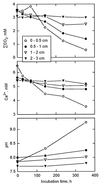Microbial manganese and sulfate reduction in Black Sea shelf sediments
- PMID: 10877783
- PMCID: PMC92088
- DOI: 10.1128/AEM.66.7.2888-2897.2000
Microbial manganese and sulfate reduction in Black Sea shelf sediments
Abstract
The microbial ecology of anaerobic carbon oxidation processes was investigated in Black Sea shelf sediments from mid-shelf with well-oxygenated bottom water to the oxic-anoxic chemocline at the shelf-break. At all stations, organic carbon (C(org)) oxidation rates were rapidly attenuated with depth in anoxically incubated sediment. Dissimilatory Mn reduction was the most important terminal electron-accepting process in the active surface layer to a depth of approximately 1 cm, while SO(4)(2-) reduction accounted for the entire C(org) oxidation below. Manganese reduction was supported by moderately high Mn oxide concentrations. A contribution from microbial Fe reduction could not be discerned, and the process was not stimulated by addition of ferrihydrite. Manganese reduction resulted in carbonate precipitation, which complicated the quantification of C(org) oxidation rates. The relative contribution of Mn reduction to C(org) oxidation in the anaerobic incubations was 25 to 73% at the stations with oxic bottom water. In situ, where Mn reduction must compete with oxygen respiration, the contribution of the process will vary in response to fluctuations in bottom water oxygen concentrations. Total bacterial numbers as well as the detection frequency of bacteria with fluorescent in situ hybridization scaled to the mineralization rates. Most-probable-number enumerations yielded up to 10(5) cells of acetate-oxidizing Mn-reducing bacteria (MnRB) cm(-3), while counts of Fe reducers were <10(2) cm(-3). At two stations, organisms affiliated with Arcobacter were the only types identified from 16S rRNA clone libraries from the highest positive MPN dilutions for MnRB. At the third station, a clone type affiliated with Pelobacter was also observed. Our results delineate a niche for dissimilatory Mn-reducing bacteria in sediments with Mn oxide concentrations greater than approximately 10 micromol cm(-3) and indicate that bacteria that are specialized in Mn reduction, rather than known Mn and Fe reducers, are important in this niche.
Figures






References
-
- Achtnich C, Bak F, Conrad R. Competition for electron donors among nitrate reducers, ferric iron reducers, sulfate reducers, and methanogens in anoxic paddy soil. Biol Fertil Soils. 1995;19:65–72.
-
- Aller R C. Bioturbation and manganese cycling in hemipelagic sediments. Phil Trans R Soc Lond. 1990;A331:51–58.
-
- Aller R C. The sedimentary Mn cycle in Long Island Sound: its role as intermediate oxidant and the influence of bioturbation, O2 and Corg flux on diagenetic reaction balance. J Mar Res. 1994;52:259–295.
-
- Berner R A. Early diagenesis. Princeton, N.J: Princeton University Press; 1980.
Publication types
MeSH terms
Substances
Associated data
- Actions
- Actions
- Actions
- Actions
- Actions
LinkOut - more resources
Full Text Sources
Molecular Biology Databases

